County Gaol and Bridewell, Bodmin, Cornwall
The Cornwall County Gaol and Bridewell was opened in 1779 on Berrycoombe Road, Bodmin. As well as housing felons and petty offenders, it was used for debtors, replacing the town's previous debtors' prison on Crockwell Street.
The building was designed by a local magistrate and former military engineer, Sir John Call, and was strongly influenced by the ideas of prison reformer John Howard, who believed that each prisoner should have their own cell. Bodmin was one of the first English prisons to adopt this principle. Construction work was undertaken by Philip Stowey and Thomas Jones of Exeter, who probably also contributed to the design. Prisoners of war provided labour for erecting the building, whose construction used 20,000 tonnes of local Delank granite, and stone from the adjacent Coocoo Quarry.
In 1784, John Howard recorded:
This new gaol is built on a fine eminence, at a little distance from the town, where there is a constant current of water. Here is a good house for the gaoler, in which there are apartments for master's-side debtors, and a chapel. There are separate rooms and courts for each sex of debtors, of felons, and of petty offenders or bridewell prisoners; and each prisoner has a separate lodging-room (about 8 feet 2 inches by 5 feet 8, and 7½ feet high), which is furnished with a bedstead, straw-bed, two blankets and a coverlet. There are two rooms for an infirmary, and under them three condemned cells. In two of the courts are baths. In the centre of the gaoler's house there is a turret with an alarm-bell and clock. The men who are confined for petty offences, are employed in sawing and polishing Bone, and, as they have the county allowance, have only one sixth of what they earn. Clauses against spirituous liquors are hung up. The act for preserving the health of prisoners is not hung up, but the gaol is now kept very neat and clean.
By a spirited exertion, the gentlemen of this county have erected a monument of their humanity, and attention to the health and morals of prisoners.
Here were committed from Jan. 13, 1780, to July 27, 1782, Debtors 75, Felons &c. 92, Petty offenders 94.
By 1788, however, Howard was less enthusiastic:
This gaol was not so clean, nor in such order as at my former visits; the gaoler, as I understand, having many avocations. The women felons and petty offenders were crowded together, though the opposite rooms were all empty. The chaplain's curate, who has but a small salary, too seldom attends. No casements to the windows in the passages; and the floors are of soft brick. The assize convicts have the king's allowance of half a crown a week. Here were some prisoners who had been several years in confinement, by a writ de excommunicato capiendo. Gaoler's salary £100. Turnkey £20 and fuel.
1788, June 26, Debtors 18. Felons 5. Petty Offenders 24.
A lengthier description of the prison was provided by James Neild in 1812:
This County Gaol, which is also the Bridewell, stands on a fine eminence, at a small distance from the town of Bodmin. It fronts the South; and the steepness of the ground appears to be of peculiar advantage in many points, by placing the several buildings one above another, and thereby giving to each a full sun, and fresh air. A copious stream of excellent water is brought in above the Gaoler's house, and distributed through every ward, for supplying the baths, with other useful purposes; and is then, ultimately, and with great propriety, carried off through the sewers; which, being thus judiciously placed and circumstanced, are never offensive.
The Prison was first inhabited in June, 1779. Its boundary wall-encloses an area of 180 feet by 145. The Turnkey's lodge is in front; and has two rooms below, and two above stairs.
The court-yard of entrance is 30 feet by 15. In the approach to the Gaoler's house the several court-yards are on different levels.
On the right, is the Men Bridewell Court, 62 feet by 47; on the left, that for the Men Felons, of the same size; and to each of them belongs a day-room 47 feet by 14, under arcades,with a bath,and a boiler for warm water to each.
Ascending up four steps is another court-yard, 50 feet by 30,with a workshop in it for vagrants, and a day-room of 40 feet by 16. From this court, the next ascent is by fifteen steps, to the court in front of the Gaoler's house, which is 30 feet square, with doors opening into four other court-yards. Of these, that on the right hand is for Bridewell Women; that on the left, for Female Felons; both are 62 feet by 20,with day-rooms 47 feet by 14,and arches for shelter and exercise in wet weather.
Higher up still, on the right-hand, is the Infirmary Court, of 54 feet by 20; adjoining to which is a passage 3 feet 6 inches wide,with three iron-grated windows. Into this passage open the three Condemned Cells, each of them 10 feet by 8, and 9 feet high to the crown of the arch: The floors are of brick, and they have each loose straw, two blankets, and a rug to sleep on. Close to the Infirmary Court, and near the Condemned Cells, there are in all four infirmary rooms, with the Surgeon's shop, or examining room, adjacent.
Opposite to the Infirmary court-yard is another of the same size, for poor, or Common-side Debtors, with arcades, 24 feet by 14, and two day-rooms,one of them 30 feet by 14, the other, 20 feet by 12. Each having a fire-place, with an oven, benches and stools to sit on, cupboards,and other conveniences for frugal cookery. Here are also six sleeping rooms, 10 feet by 7, and 8 feet 9 inches high; each calculated to accommodate two debtors, and for which, those on the Common Side pay 9d. per week, or 1s. 6d. for a single bed.
In short, the Magistrates have here established a lasting monument of their humanity, by displaying a very liberal attention, both to the health and morals of the Prisoners.
The Gaoler's house, placed in the centre of the Prison, has a turret, with an alarm bell and clock. For the Master's Side Debtors are set apart four good rooms, well furnished, at 2s. 6d. each single bed per week, or if two sleep together, 1s. 3d. each; but if a Debtor brings his own bed, 1s. 3d. per week for the room. They have likewise the indulgence of a very neat semicircular garden, 160 feet by 80, lying on the North side of the house; in which, not only they, but the convalescent criminals also, occasionally take the air at proper times.
The Chapel, 30 feet by 20, is within the centre building. The Criminal Prisoners are seated below, the women are placed out of sight of the Men, and a pew is appropriated to Convicts under sentence of death. The Debtors, and the Gaoler's family severally occupy the galleries. All are required to attend Divine service: Their behaviour, at my several visits, was orderly and devout, so as to answer the idea of a House of Prayer, and the duty was impressively performed by the worthy Chaplain.
I well remember, that in October, 1803, the Psalm read for the day happened singularly to be the LXXIXth. The three poor Men-convicts, then under sentence of death, were present, and appeared very sensibly affected by that pathetick ejaculation in the concluding part of the 12th verse; "Preserve thou those that are appointed to die!" It was not a Psalm specially selected for the solemn occasion; but it was rendered, therefore, the more striking. By the way, it might be exceedingly useful to have selections, for times like the above; and many of the Psalms are peculiarly suitable and appropriate.
In this Gaol, the humane, active, and intelligent Keeper furnishes employment for all those Prisoners who are willing to work: And, indeed, all criminals here, who receive the County Allowance, as well as those committed for hard labour, must work, in order to have it, if well in health, and able so to do. The Women card and spin wool, or make, mend, and wash the other prisoners' clothes and bedding. The Men are chiefly employed in sawing timber, for which a double saw-pit is provided; or in sawing and polishing head-stones for church-yards; or else in weaving at the looms, which are also ready prepared. This the Gaoler takes charge of,and lays in the materials for labour, at his own risk of sale, when the work is done. By these means many, under his care,have been enabled to send a comfortable relief to their families; and others, from the exercise of talent, and acquiring habits of activity, have, in a prison, created to themselves a new resource for their industry, when discharged from it. In proof of this, and to the honour of the Keeper, I was informed, that one Prisoner, sometime after being discharged from hence, declared, "that the day of his commitment was the most fortunate of his life, as he had learnt here the trade of a sawyer, by which he could earn two guineas a-week." Such may be the happy effect of diligence in a Gaol: and, sensible of such effects, the Magistrates very judiciously allow to Mr. Chapple that portion (a fourth-part) of nett earnings from the labour of the Prisoners, which formerly was paid to the County.
If a Debtor works here, he has the whole of what he earns to himself. Those Criminals that are employed in preparing timber and stone, have one-half of their earnings, beside the County Allowance: and the Women have the same, who are occupied in spinning and carding of wool.
The various rooms and court-yards of this Gaol, are (with some exceptions, which I shall presently notice,) kept distinct and separate for each class and sex of offenders. Every such Prisoner has a separate lodging-room, of about 8 feet 4 inches by 5 feet 4, and 9 feet 8 inches high; furnished with a wooden bedstead, straw bed, two blankets, and a coverlet. In each court-yard there is a stone-trough,with a pipe and cock, to supply each ward constantly with water.
Closely adjoining to three of the day-rooms, are baths and boilers, with ovens for purifying the clothes of those who are newly admitted. When a Prisoner is brought into custody, the Surgeon is sent for to examine him. If found unwell, medicines are sent him; if ragged and dirty, he is stripped, washed in the bath, and the County clothing substituted for his own.
The Men's Gaol is two stories high, and contains eight cells on each floor, divided from the court by a passage of 4 feet 6 inches wide. Their Bridewell is the same. The Women's Gaol and Bridewell are one story high, each of them containing seven cells, divided by a lobby, or passage, the same as for the Men. Here is also a large work-room, with several looms for weaving; and a court-yard to work in, of 138 feet by 96.
In the important discharge of his duty, the Surgeon is very attentive and humane. The Prison is frequently visited by the Magistrates, and kept very clean. All the apartments are white-washed twice a-year, and the sleeping-cells four times a year. The floors of the day-rooms and cells are washed once a-week in winter, twice in summer, and swept out every day.
It is worthy of especial remark, that out of 3877 Prisoners, there happened but fifteen deaths in the space of twenty-seven years: strong proofs not only of the healthy situation of this Gaol, but of that good government also, which assiduously keeps it such.
And yet, like so many others, it has, in some instances, its inconveniences, or defects. There is still wanting a distinct court-yard for Convicts; who, too often, remain a long time here after sentence, and should certainly be separated from such Prisoners as are committed for trial. Another court-yard also is essentially desirable, in order to preserve a proper separation betwixt young beginners in vice, and such old offenders, as are both hackneyed and hardened in the practice of every enormity. But — I speak not to deaf ears.
From the 4th of Oct. l802, to the 5th of Oct. 1803, the number of Prisoners committed to the Bridewell was 85. Their earnings during that period amounted to £117. 8s. 0d. of which sum the working Prisoners received one-half; the Keeper one-quarter; and the remainder was paid into the County stock.
Statement of Prisoners in general, from January, 1780, to February 17th, 1807, received here during the course of 27 years,
| Gaol. | Bridewell | Debtors | Totals | |
| Commitments | 1258 | 1846 | 773 | 3877 |
| Deaths | 2 | 5 | 8 | 15 |
Prisoners are always discharged from hence in a morning; and, if necessitous, money is given them, according to their respective distance from home.
The prison's rules at this period are reproduced on a separate page.
Although inmate numbers were relatively low in the gaol's early years, by 1820 the cells regularly had with multiple occupants. To deal with the overcrowding, the buildings were extended several times up to 1850. With an increase in legal requirements to segregate different class of inmate, such as remand prisoners, convicted prisoners, felons, debtors, vagrants, and men from women, the prison was largely rebuilt in 1856-61.
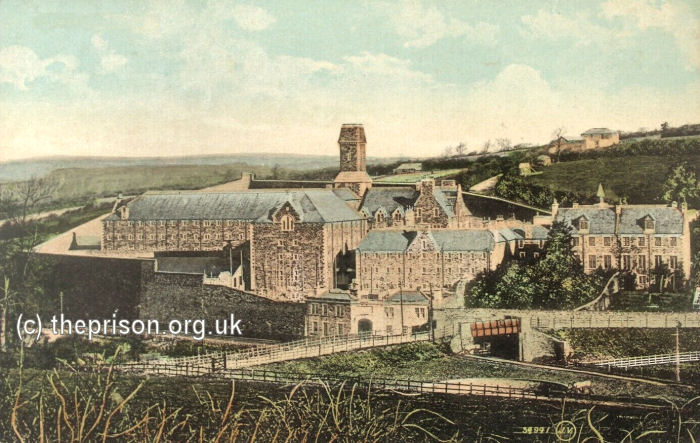
County Gaol and Bridewell, Bodmin, from the south-east c.1905. © Peter Higginbotham
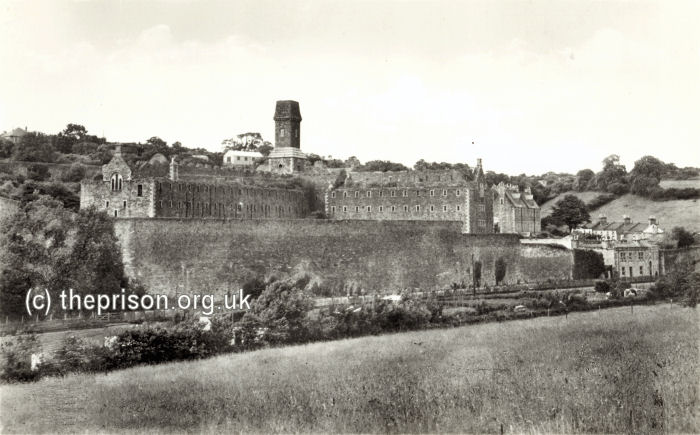
County Gaol and Bridewell, Bodmin, from the south-west c.1905. © Peter Higginbotham
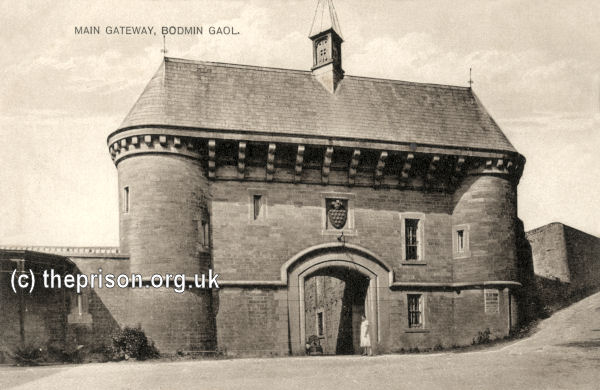
County Gaol and Bridewell, Bodmin - main gateway c.1905. © Peter Higginbotham
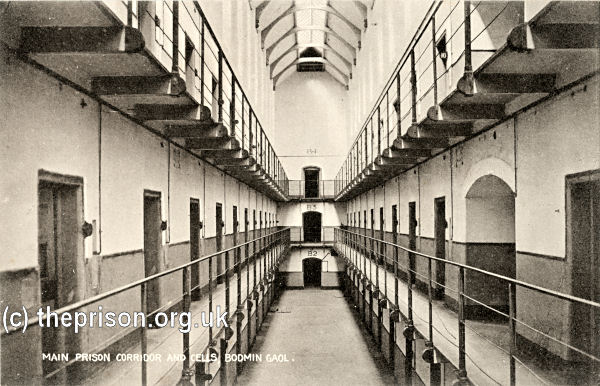
County Gaol and Bridewell, Bodmin - cell wing c.1905. © Peter Higginbotham
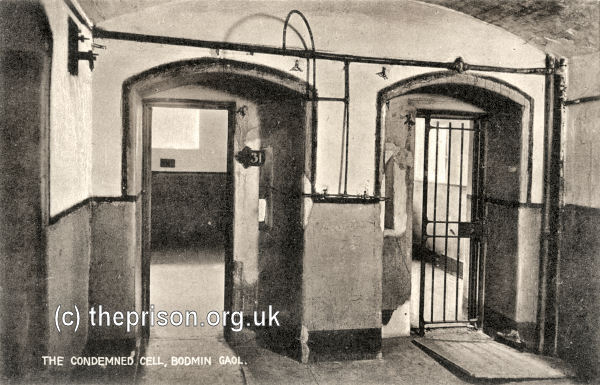
County Gaol and Bridewell, Bodmin - condemned cell c.1905. © Peter Higginbotham
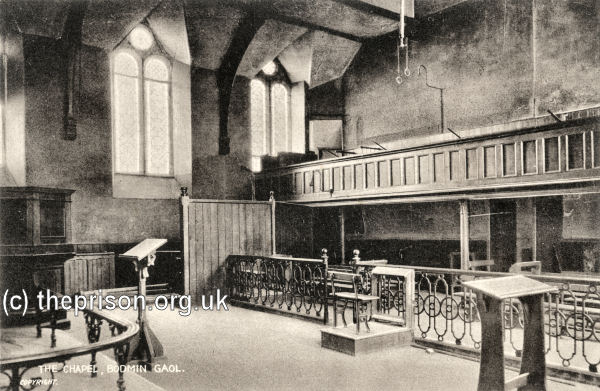
County Gaol and Bridewell, Bodmin - chapel interior c.1905. © Peter Higginbotham
From 1887 to 1922, parts of the building were as a naval prison.
Use of the prison for female inmates ended in 1911 with the remaining women being transferred to HMP Plymouth.
The last male prisoner left Bodmin Jail in July 1916. During the First World War, the site was used for storing some of Britain's national treasures including the Domesday Book and the Crown Jewels.
The prison was finally closed in 1927. In 1930, the building became home to a casino, nightclub and an attraction staging mock executions. However, the fabric rapidly deteriorated after part of the roof was removed for repairs. Some restoration work began in 2004 and the building is now home to a hotel and museum.
Records
Note: many repositories impose a closure period of up to 100 years for records identifying individuals. Before travelling a long distance, always check that the records you want to consult will be available.
- Cornwall Archives, Kresen Kernow, Little Vauxhall, Redruth TR15 1AS.
- The National Archives, Kew, Richmond, Surrey, TW9 4DU. Has a wide variety of crime and prison records going back to the 1770s, including calendars of prisoners, prison registers and criminal registers.
- Find My Past has digitized many of the National Archives' prison records, including prisoner-of-war records, plus a variety of local records including Manchester, York and Plymouth. More information.
- Prison-related records on
Ancestry UK
include Prison Commission Records, 1770-1951
, and local records from London, Swansea, Gloucesterhire and West Yorkshire. More information.
- The Genealogist also has a number of National Archives' prison records. More information.
Census
Bibliography
- Johnson, Bill The History of Bodmin Gaol (2009, Bodmin Town Museum)
Links
- Bodmin Jail Attraction
- Prison Oracle - resources those involved in present-day UK prisons.
- GOV.UK - UK Government's information on sentencing, probation and support for families.
Except where indicated, this page () © Peter Higginbotham. Contents may not be reproduced without permission.



